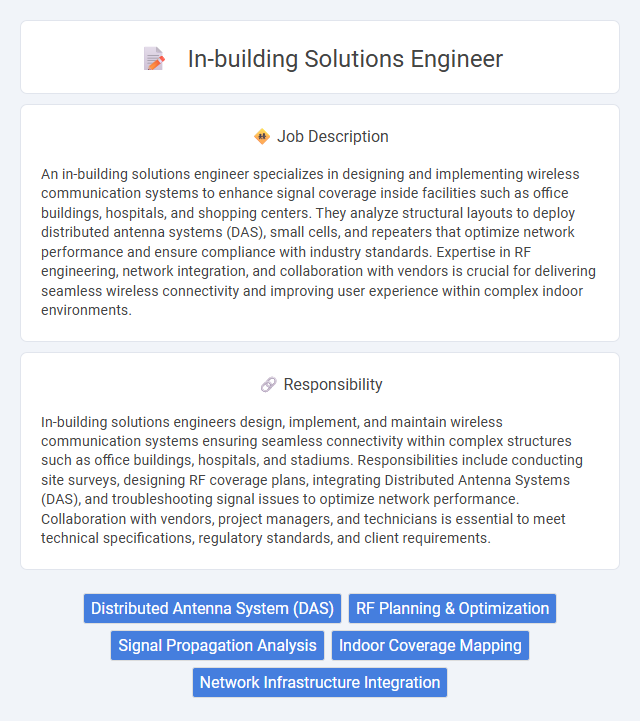
An in-building solutions engineer specializes in designing and implementing wireless communication systems to enhance signal coverage inside facilities such as office buildings, hospitals, and shopping centers. They analyze structural layouts to deploy distributed antenna systems (DAS), small cells, and repeaters that optimize network performance and ensure compliance with industry standards. Expertise in RF engineering, network integration, and collaboration with vendors is crucial for delivering seamless wireless connectivity and improving user experience within complex indoor environments.
People with strong problem-solving skills and technical aptitude are likely suitable for an in-building solutions engineer role, as the job involves designing and implementing communication systems within complex building environments. Those comfortable working in dynamic, collaborative settings and managing multiple projects simultaneously may find the position aligns well with their capabilities. Individuals preferring routine tasks or limited interaction with evolving technology might find the role less compatible with their preferences.
Qualification
A qualified In-building Solutions Engineer typically holds a bachelor's degree in electrical engineering, telecommunications, or a related field, with certifications such as BICSI or DAS design preferred. Experience with distributed antenna systems (DAS), RF design, and network troubleshooting is essential for effective signal optimization within complex structures. Strong analytical skills and proficiency in industry-standard tools like iBwave and Spectrum Analyzer are crucial for ensuring robust indoor wireless connectivity.
Responsibility
In-building solutions engineers design, implement, and maintain wireless communication systems ensuring seamless connectivity within complex structures such as office buildings, hospitals, and stadiums. Responsibilities include conducting site surveys, designing RF coverage plans, integrating Distributed Antenna Systems (DAS), and troubleshooting signal issues to optimize network performance. Collaboration with vendors, project managers, and technicians is essential to meet technical specifications, regulatory standards, and client requirements.
Benefit
In-building solutions engineers likely enhance wireless network performance within complex structures, improving connectivity and user experience. Their expertise probably reduces signal dropouts and increases data speeds, which benefits businesses and residents by ensuring reliable communication. Employers may experience higher customer satisfaction and operational efficiency due to the optimized network infrastructure provided by these engineers.
Challenge
In-building solutions engineers likely face complex challenges related to designing and implementing reliable wireless coverage within diverse architectural environments, where signal interference and structural obstacles can significantly impact performance. The role probably requires continuous problem-solving to optimize network infrastructure, ensuring consistent connectivity for users in dense or obstructed indoor spaces. Challenges may also include balancing technical specifications with client needs and budget constraints, demanding both technical expertise and adaptive project management skills.
Career Advancement
In-building solutions engineers design and implement wireless communication systems to enhance indoor connectivity, specializing in technologies like Distributed Antenna Systems (DAS) and small cells. Mastery of RF engineering principles and proficiency in project management accelerate career progression from junior engineer roles to senior technical positions and managerial roles within telecommunications firms. Continuous skill development in emerging 5G and IoT infrastructure technologies opens pathways to leadership roles and high-level consultancy opportunities.
Key Terms
Distributed Antenna System (DAS)
In-building solutions engineers specializing in Distributed Antenna System (DAS) design and implementation ensure robust wireless connectivity within complex structures. They analyze building layouts to optimize DAS deployment, enhancing signal coverage for cellular, public safety, and Wi-Fi networks. Expertise in RF engineering, network integration, and regulatory compliance is critical to deliver seamless in-building communication solutions.
RF Planning & Optimization
In-building solutions engineers specializing in RF planning and optimization design and implement wireless network systems to ensure reliable indoor coverage and capacity. They analyze signal propagation, perform site surveys, and optimize antenna placement to mitigate interference and maximize network performance. Expertise in DAS, small cells, and RF modeling tools is essential for enhancing signal quality and supporting seamless connectivity within complex building environments.
Signal Propagation Analysis
In-building solutions engineers specializing in signal propagation analysis design and optimize wireless communication systems to ensure seamless coverage within complex indoor environments. They utilize advanced propagation modeling tools and perform site surveys to assess signal strength, identify interference sources, and develop customized antenna placements that maximize network performance. Expertise in RF propagation characteristics and materials attenuation is crucial for delivering reliable connectivity in commercial, industrial, and residential buildings.
Indoor Coverage Mapping
Indoor Coverage Mapping is a critical task for In-building Solutions Engineers, involving the precise analysis and visualization of wireless signal strength within complex indoor environments. This process leverages advanced tools such as spectrum analyzers, signal scanners, and predictive modeling software to identify coverage gaps and optimize network performance. Accurate mapping ensures seamless connectivity, supporting enhanced communication for enterprises and critical infrastructures.
Network Infrastructure Integration
An In-building Solutions Engineer specializing in Network Infrastructure Integration designs and implements advanced wireless systems to enhance connectivity within complex structures such as office buildings, stadiums, and hospitals. This role requires expertise in integrating distributed antenna systems (DAS), small cells, and fiber optic networks to ensure seamless signal coverage and capacity. Proficiency with RF engineering tools, network protocols, and collaboration with carriers and IT teams is essential for optimizing indoor network performance.
 kuljobs.com
kuljobs.com